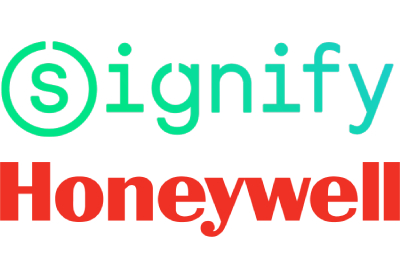Signify and Honeywell Collaborate on Integrated Lighting Solutions

Jan 5, 2021
Signify and Honeywell has announced a strategic alliance to deploy integrated, smart lighting solutions for commercial buildings. Together, the companies aim to improve the occupant experience – focusing on productivity and wellbeing – and to reduce energy consumption.
The collaboration integrates Signify’s Interact connected lighting system and software, and its UV-C disinfection lighting, with Honeywell Building Management Systems and the Honeywell Forge enterprise performance management platform. The combined offerings will manage energy consumption while factoring in occupancy along with air quality indicators such as temperature and humidity. Signify’s lighting solutions* will complement Honeywell’s Healthy Buildings air quality solutions beginning in early 2021, and can be controlled, measured and monitored via the Healthy Buildings dashboard to understand air and surface cleaning compliance and metrics.
Honeywell and Signify are deploying integrated offerings at OPTIMAX Eye Specialists, a network of leading eye specialist clinics in Malaysia, to help the organization improve its air quality and surface disinfection efforts.
The clinics are using Signify UV-C lighting in upper air luminaries, stand-alone trolleys and in Honeywell-controlled fan coil units to increase wellbeing by contributing to disinfect air± and surfaces§ in rooms. Honeywell’s Healthy Buildings dashboard will control and monitor the Signify lighting technologies in the clinics.
The integrated Honeywell and Signify products can support the needs of any building and feature specific solutions for premium commercial buildings, airports, hospitality, healthcare, education, retail and stadia sectors. Honeywell and Signify are also currently deploying the integrated solutions, including Signify’s Philips UV-C disinfection upper air luminaires, in several Honeywell global offices.
* Signify’s products (including its UV-C air and surface disinfection products) are not medical devices, they are not approved, certified or registered as medical devices in any jurisdiction, and are not meant by Signify to be used for the disinfection of medical devices or for other medical purposes.
± The germicidal effectiveness of UV-C light sources is proportional to the exposure time of the microorganism to the UV-C light source and the intensity of the UV-C light source. Therefore, sufficient air flow in the room (which may be achieved through forced air flow or natural convection) is required for effective operation of Signify’s UV-C upper air disinfection luminaire solutions.
§ Signify’s UV-C surface disinfection products (fitted with Signify’s UV-C light sources) will achieve the same level of virus infectivity reduction as long as the same UV-C dose is achieved on each area of surface that is irradiated.
References
i Nadia Storm et al, Rapid and complete inactivation of SARS-CoV-2 by ultraviolet-C irradiation, 2020. Subject to peer review and available only as a pre-print at https://www.researchsquare.com/article/rs-65742/v2. The UV-C irradiance used in this study was 0.849 mW/cm2.
iv The Climate Group, Smarter energy: accelerating business use of indoor connected LED lighting, October 19 2020 [Accessed December 14, 2020]
v Pacific Northwest National Laboratory, Impacts of Commercial Building Controls on Energy Savings and Peak Load Reduction, May 2017 [Accessed November 17, 2020]











